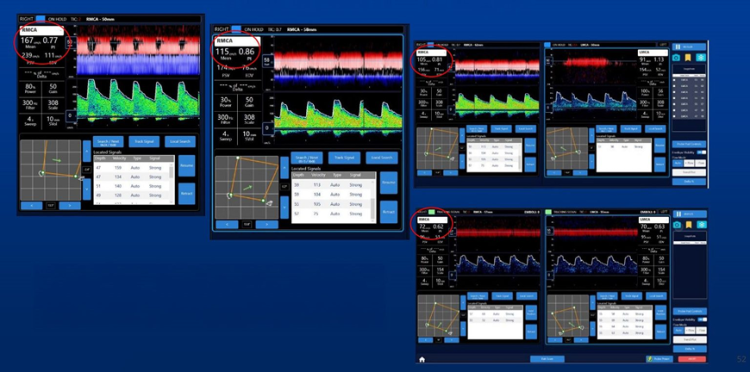Hemodynamic monitoring plays a pivotal role in critical care, stroke management, and neurosurgical interventions. As healthcare providers seek non-invasive, real-time, and accurate tools to understand cerebral perfusion dynamics, Transcranial Doppler (TCD) ultrasound has emerged as a transformative solution. In particular, innovations like NeuraSignal’s NG2 Intelligent Ultrasound platform are pushing the boundaries of what clinicians can achieve in hemodynamic monitoring. This blog explores the profound role of TCD ultrasound in hemodynamic monitoring, especially as it pertains to cerebral blood flow regulation, clinical decision-making, and improving patient outcomes.
Understanding Hemodynamic Monitoring in the Brain
Hemodynamic monitoring involves the continuous assessment of blood flow dynamics, ensuring vital organs receive adequate perfusion. In the brain, this is particularly critical due to its sensitivity to ischemia and hypoperfusion. Traditional hemodynamic monitoring techniques such as invasive arterial lines or MRI perfusion studies offer partial insights and are often limited by complexity, risk, or logistics.
TCD ultrasound, on the other hand, uses low-frequency sound waves to measure cerebral blood flow velocity in major intracranial arteries, such as the middle cerebral artery (MCA). This m
ethod offers a dynamic, real-time window into cerebral hemodynamics, without the need for ionizing radiation or surgical access.
Key emodynamic Parameters Measured by TCD
TCD ultrasound facilitates the measurement of several key hemodynamic indicators:
Mean Flow Velocity (MFV): Reflects the average velocity of blood flow within cerebral vessels.
Pulsatility Index (PI): Provides insight into downstream vascular resistance.
Vasomotor Reactivity (VMR): Assesses how cerebral vessels respond to changes in carbon dioxide levels.
Emboli Detection: Identifies the presence of microembolic signals, providing critical insights into stroke risk.
These parameters are essential for clinicians managing patients with traumatic brain injury (TBI), stroke, subarachnoid hemorrhage (SAH), and during perioperative neurosurgical monitoring.
NeuraSignal’s NG2: Empowering Clinicians with Robotic TCD
Traditional TCD has been operator-dependent, limiting its broader use in real-time critical care scenarios. NeuraSignal’s NG2 Intelligent Ultrasound addresses this challenge by combining robotics and AI to autonomously locate the temporal bone window and acquire accurate TCD readings.
Key capabilities of NG2 include:
Automated Probe Positioning: The robotic arm mimics human technique, making TCD more accessible.
Live Data Streaming: Enables remote monitoring and interpretation.
AI-Powered Signal Detection: Identifies blood flow patterns and emboli autonomously.
Trend Monitoring: Tracks hemodynamic changes over time to support treatment planning.
This level of automation reduces the learning curve, allowing nurses and non-specialist providers to use TCD in intensive care settings.
Clinical Applications in Hemodynamic Monitoring
1.Post-Thrombectomy Monitoring
After mechanical thrombectomy (MT), patients are at risk for reperfusion injury and hyperperfusion syndrome. TCD enables continuous monitoring of MCA velocities, flagging abnormal increases that may indicate dangerous shifts in perfusion.
A study cited by NeuraSignal showed that TCD parameters could predict good outcomes and the risk of reperfusion injury post-MT, enabling proactive blood pressure management to mitigate complications.
2.Subarachnoid Hemorrhage and Vasospasm
Approximately 70% of SAH patients develop cerebral vasospasm, a leading cause of delayed ischemic neurological deficits (DINDs). TCD is the only bedside modality capable of non-invasively monitoring for vasospasm.
Velocity thresholds such as:
>120 cm/s suggest mild vasospasm
>200 cm/s indicate severe vasospasm
Through continuous TCD monitoring, clinicians can initiate hypertensive therapy or intra-arterial vasodilators early, improving patient outcomes.
3.Traumatic Brain Injury (TBI)
In TBI management, TCD assists in evaluating cerebral autoregulation by monitoring VMR. If the response to CO2 challenges is blunted, it may indicate impaired autoregulation and risk for secondary injury. NeuraSignal’s automation ensures these tests can be conducted frequently and with consistent methodology.
4.Cardiac Surgery and Emboli Monitoring
TCD is widely used to detect cerebral emboli during procedures like carotid endarterectomy and cardiac valve replacement. Continuous emboli monitoring provides real-time feedback, allowing surgeons to alter their technique or deploy protective strategies to reduce embolic burden.

Benefits of TCD in Hemodynamic Monitoring
Continuous, Real-Time Monitoring
TCD enables clinicians to observe real-time shifts in cerebral perfusion, crucial during dynamic phases such as post-operative recovery or acute stroke intervention.
Non-Invasive and Safe
Unlike invasive monitors, TCD poses no risk of infection, bleeding, or arterial damage. It is well-suited for repeat measurements across extended periods.
Portable and Scalable
Devices like NG2 are compact and ideal for use in ICUs, stroke units, and even rural settings. Cloud-based data storage enables remote analysis by specialists.
Operator Independence
With NeuraSignal’s AI-powered guidance and automation, facilities lacking neurovascular sonographers can still access expert-grade data.
Quantitative and Actionable
TCD readings provide numerical values that correlate with clinical severity and can be trended over time to guide decisions.
TCD as a Prognostic Tool
Several studies have shown that abnormalities detected through TCD correlate with poor neurological outcomes. For example:
High Pulsatility Index: Suggests elevated intracranial pressure.
Low VMR: Correlates with impaired collateral flow in carotid stenosis.
Persistent Hyperemia: Indicates risk of reperfusion injury.
Such insights support early intervention, optimizing treatment windows in neurocritical care.
Remote Monitoring and Telemedicine
One of NG2’s strongest attributes is its ability to integrate with telemedicine workflows. Exams can be streamed live and reviewed off-site, giving stroke neurologists and neurointensivists access to vital hemodynamic data in real time. This capability is crucial in expanding quality care access to under-resourced hospitals and rural centers.
Moreover, longitudinal trend analysis across 14-day periods, as offered by the NG2 platform, helps clinicians evaluate treatment efficacy and disease progression, particularly in chronic cerebrovascular patients.
Case Studies Illustrating Impact

Case 1: Vasospasm Detection Post-Aneurysm Clipping
A 60-year-old female underwent aneurysm coiling and hemicraniectomy. TCD showed elevated MCA velocities (167 cm/s) and a Lindegaard ratio of 6.68. Intervention with intrathecal nicardipine reduced velocities significantly, as confirmed by follow-up TCD.
Case 2: Perfusion Fluctuations After Stroke
Continuous TCD monitoring in a post-MT patient revealed transient surges in MCA velocity, prompting blood pressure modulation. These adjustments helped mitigate secondary complications and guided recovery protocols.
Addressing Challenges and Limitations
While TCD ultrasound is a powerful tool, its historical limitations included:
Operator dependency
Difficult acoustic windows in some patients
NG2 solves both through automation, robotic positioning, and AI-driven signal analysis. Additionally, integration with hospital PACS and EMR systems ensures easy documentation and communication of results.

Clinical Guidelines and Evidence Support
Multiple neurology and imaging societies endorse TCD for hemodynamic monitoring:
AHA/ASA: Recommends TCD for vasospasm surveillance post-SAH.
AAN: Rates TCD as Level A evidence for detecting angiographic vasospasm.
ASN: Endorses TCD’s role in managing cerebral autoregulation and blood flow dynamics.
Furthermore, NeuraSignal’s platform has received FDA clearance and is backed by extensive peer-reviewed research and NIH-funded studies.
TCD as the Future of Cerebral Hemodynamic Monitoring
TCD ultrasound, especially in its modern AI-assisted, robotic form as seen in NeuraSignal’s NG2, is redefining how clinicians monitor cerebral blood flow. With its ability to deliver real-time, quantitative, and non-invasive insights into cerebral hemodynamics, TCD bridges the gap between diagnostic imaging and bedside monitoring.
From acute stroke to chronic cerebrovascular disease, from SAH vasospasm to embolic detection during surgery, TCD is a cornerstone technology for patient-centered cerebral care. As hospitals seek scalable, portable, and reliable monitoring tools, TCD’s role will only expand—ushering in a new era of proactive neurocritical care.
For providers and health systems, adopting advanced TCD platforms like NG2means not only improving patient outcomes but also optimizing workflows and resource allocation in a field where time and precision are everything.